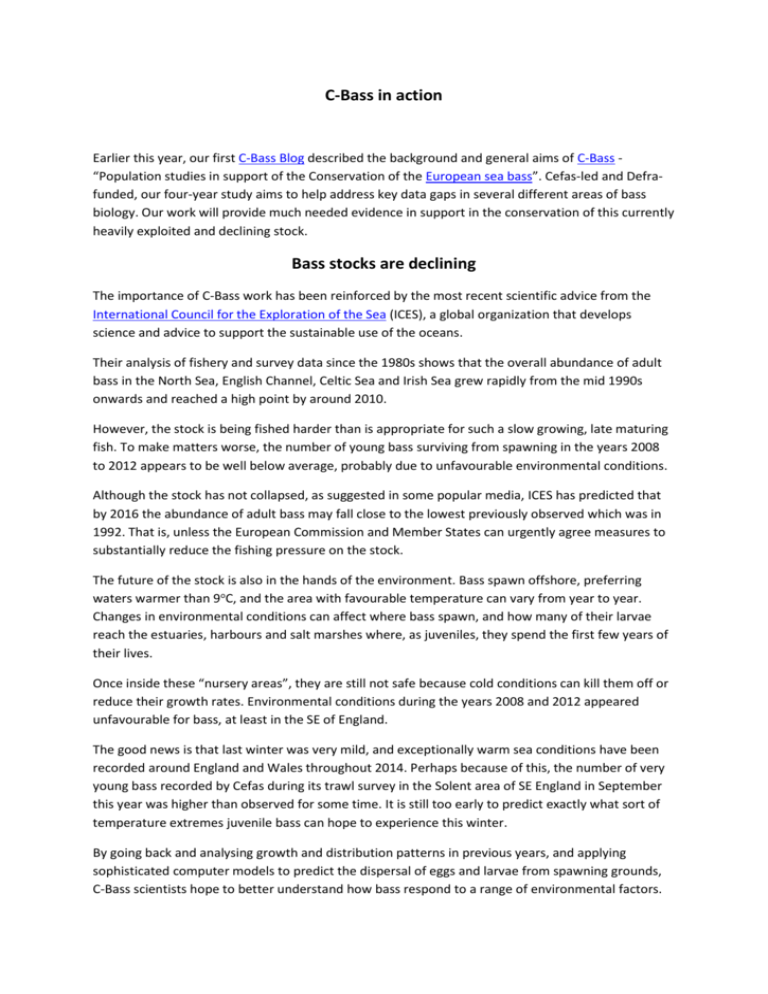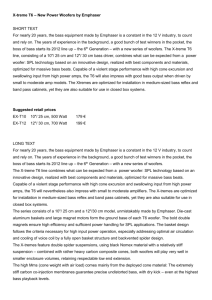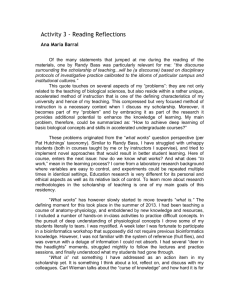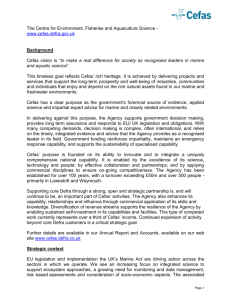Paper 8.1 C-Bass in action (For info)
advertisement

C-Bass in action Earlier this year, our first C-Bass Blog described the background and general aims of C-Bass “Population studies in support of the Conservation of the European sea bass”. Cefas-led and Defrafunded, our four-year study aims to help address key data gaps in several different areas of bass biology. Our work will provide much needed evidence in support in the conservation of this currently heavily exploited and declining stock. Bass stocks are declining The importance of C-Bass work has been reinforced by the most recent scientific advice from the International Council for the Exploration of the Sea (ICES), a global organization that develops science and advice to support the sustainable use of the oceans. Their analysis of fishery and survey data since the 1980s shows that the overall abundance of adult bass in the North Sea, English Channel, Celtic Sea and Irish Sea grew rapidly from the mid 1990s onwards and reached a high point by around 2010. However, the stock is being fished harder than is appropriate for such a slow growing, late maturing fish. To make matters worse, the number of young bass surviving from spawning in the years 2008 to 2012 appears to be well below average, probably due to unfavourable environmental conditions. Although the stock has not collapsed, as suggested in some popular media, ICES has predicted that by 2016 the abundance of adult bass may fall close to the lowest previously observed which was in 1992. That is, unless the European Commission and Member States can urgently agree measures to substantially reduce the fishing pressure on the stock. The future of the stock is also in the hands of the environment. Bass spawn offshore, preferring waters warmer than 9oC, and the area with favourable temperature can vary from year to year. Changes in environmental conditions can affect where bass spawn, and how many of their larvae reach the estuaries, harbours and salt marshes where, as juveniles, they spend the first few years of their lives. Once inside these “nursery areas”, they are still not safe because cold conditions can kill them off or reduce their growth rates. Environmental conditions during the years 2008 and 2012 appeared unfavourable for bass, at least in the SE of England. The good news is that last winter was very mild, and exceptionally warm sea conditions have been recorded around England and Wales throughout 2014. Perhaps because of this, the number of very young bass recorded by Cefas during its trawl survey in the Solent area of SE England in September this year was higher than observed for some time. It is still too early to predict exactly what sort of temperature extremes juvenile bass can hope to experience this winter. By going back and analysing growth and distribution patterns in previous years, and applying sophisticated computer models to predict the dispersal of eggs and larvae from spawning grounds, C-Bass scientists hope to better understand how bass respond to a range of environmental factors. As a result, we can better predict how bass stocks will behave in the future, for example, in relation to rising sea temperatures. C-Bass raises the “bar” with Anglo-French collaboration In C-Bass, we are working closely with our French colleagues at Ifremer, who are running a parallel bass research programme called “BARGIP” (“bar” is French for “bass”). Scientists at Ifremer and the Iroise Sea Marine Natural Park in west Brittany have already demonstrated impressive results about bass migrations following the release, in 2010, 2011 and 2012, of around 250 bass tagged with electronic Data Storage Tags (DSTs). The fish were released in the Iroise Sea, a known bass summer feeding ground off the north-west of France. The DSTs continuously record temperature and pressure (depth) until the fish are recaptured. Analysis of the returned data and recapture positions shows that some of the tagged fish migrated south into the Bay of Biscay, while others migrated north into the western approaches and the Celtic Sea. One fish showed no directed migration, and instead remained in the vicinity of the Iroise Sea. Like C-Bass, BARGIP is focussed on the acquisition of scientific data and knowledge to improve the management of bass fisheries in the North-East Atlantic. There are many similarities between the two projects, with BARGIP focusing on analysis of commercial and recreational fisheries data, identifying bass nursery areas on the French coast, and carrying out tagging to track fish movements. This summer, BARGIP have already released around half of their formidable 1200 planned DSTtagged bass, the remaining releases planned for 2015. You can read about the BARGIP project and see a map of release locations at: http://wwz.ifremer.fr/bar_eng/The-Bargip-project2 Like BARGIP, C-Bass is using tagging to better understand the migration patterns of mature bass around the UK. Cefas have a long history of leading edge research using state-of-the-art tagging and tracking technology to understand the movements and behaviour of marine organisms. Cefas released the first ever DST-tagged bass in 2005, and our work to date has included studies focussed on plaice, cod, sharks and rays, eels, tuna, crabs and even jellyfish! You can read about our tag development work at: http://www.cefas.defra.gov.uk/media/579903/fish&chipsreview_final_ctl_v2.pdf C-Bass hit the water The release positions of tagged fish are being coordinated between C-Bass and BARGIP, as far as possible, to ensure good coverage of the bass population. C-Bass is covering the Channel on the UK side, with releases off Weymouth to the west, and Eastbourne in the east. So far, our French colleagues have released DST-tagged bass from Dunkirk in the eastern Channel to Saint Brieuc in the west, with additional releases in between planned in 2015. Together, we aim to fully describe the dynamics of bass in the English Channel. After much deliberation over vessels, logistics and catch rates (and our thanks to all of our volunteers!), Cefas tagging experts went to sea in early November. Day one of tagging tested our experts’ sea-legs and open-air surgical skills, but by day two conditions had calmed to near perfect. With steady catches, and a finely tuned tagging routine, by the end of day four our first 48 DSTtagged C-bass were happily swimming freely in the water, doing their own thing off the splendid Jurassic Coast. Our thanks go to skipper Bob Hope, and crew of the Kelsey Jane (Weymouth), who were our able bass catchers and obliging hosts. By happy coincidence, over the course of this work, we were also handed a returned BARGIP tag, which we were able to download and return to Ifremer. As it turned out, the returned tag was one of the first BARGIP releases, from a fish that was tagged off Dunkirk in north-east France in June. Note that any tag, English or French, from fish caught in UK waters or elsewhere, can be returned through Cefas. The data recovered suggest that this individual moved steadily south west through the Channel over the course of three months before being captured off Dorset in October (see plot below). Tracks are reconstructed based on the best fit between the depths and temperatures recorded by the tag, and the swimming abilities of the fish. We will describe this process in more detail at a later date What to do if you catch a tagged fish? In order to ensure the highest possible standards, and consistency in our results, Cefas and Ifremer have adopted the same bass-tagging methods where possible. Animal welfare takes priority in all of the work that we do, and our scientists lead internationally with regards welfare standards. Our tagged fish have internally implanted DSTs located in the body cavity of the fish. Implanting the tags ultimately minimises any negative impacts of the tags on the tagged fish. You can recognise DST-tagged bass from supplementary identification tags attached either from the dorsal fin or a spaghetti tag trailing below the anal fin. Additionally, the Ifremer fish also have a tattoo on the belly (see our joint Cefas-Ifremer reward poster, above). If you find a tagged sea bass, please take a note of where and when the fish was captured and keep the whole fish with its tags. Our tags all have a bright orange flotation jacket, so even if a fish dies prior to being recaptured, the tags will float and will eventually wash up on a beach. Tag returns from beachcombers and sharpeyed dog walkers have boosted our tag return rates in previous research programmes, sometimes by up to 10%, which makes a big difference to our results. Some of our UK-based returnees found their language skills challenged after logging on to the Ifremer site, so to make tag returns (and the payment of associated rewards!) as easy as possible, all tags can now be returned through Cefas. In the coming weeks a single reward poster will be distributed (see above), encouraging the return of ALL DST-tagged bass in UK waters via Cefas, whether these originate from France or the UK. In summary, if you find a tag or tagged fish: Note the date and location of the recovery Freeze or put the whole fish on ice Then contact Cefas, either by Web: http://www.cefas.defra.gov.uk/industry-information/returning-tagged-fish-and-shellsh.aspx E-mail: FTH@cefas.co.uk Telephone: +44 1502 524 526 Post: Cefas, Pakefield Road, Lowestoft, Suffolk NR33 0HT And finally... The evidence that we gather as a result of C-Bass work is intended to improve our understanding of the biology and fisheries for bass, and hence to improve the quality of fishery management advice for this species. The aspects of the biology of bass that we are interested in, and the impacts of fishing, are complex and we often have to try and understand these with data that are far from perfect. To help make progress, we often use the available data to develop computer simulation models that capture our current understanding, and use these to explore different hypotheses about how the real world “works”. Our next update will focus on how our models are helping us to understand egg and larval dispersal and recruitment patterns, and how the migration patterns of adult fish may influence any management regime imposed on the fishery. For more information, read the C-Bass blog or contact ewan.hunter@cefas.co.uk.







